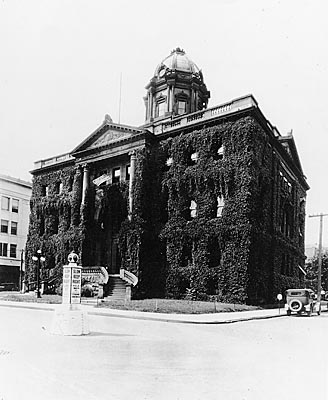One Hundred Years of Collecting
State Archives Centennial
By Gordon Simmons

The Capitol Annex in downtown Charleston was home to the West Virginia State Archives and the State Museum from their inception, in 1905, until 1929. This undated photograph is courtesy of the Kanawha County Public Library.
In 1906, state historian and archivist Virgil A. Lewis reported to Governor W.M.O. Dawson that the year-old West Virginia State Archives held a total of 23,162 books and pamphlets and an estimated 2,000 maps, charts, and drawings. At the time, this fledgling collection was housed in a 105' x 82' room on the third floor of the State Capitol Annex in downtown Charleston, a space shared with museum artifacts until 1910. After that, an assistant archivist was hired, allowing separate locations, though the State Museum and State Archives remained a single entity until 1989.
The Capitol Annex was located on the block between Hale, Lee, and Dickinson streets, across from the main Capitol building. Architect Harrison Albright had designed the Annex, an imposing structure that included a large dome, allowing it to compete visually with the massive Capitol. In addition to the State Museum and Archives, the Annex housed the State Supreme Court, the state law library, and the offices of the auditor, treasurer, and adjutant general.
It was fortunate that the newly created State Archives were paired with the Museum in the Annex; both were out of harm’s way when the main Capitol building burned to the ground in 1921. On December 27, 1966, the Annex — vacant, abandoned, and awaiting demolition — itself caught fire and was destroyed.
From 1929 to 1976, the Archives and Museum were housed in various quarters within the current Capitol building. After that, both were moved to the new Science and Culture Center, today known as the Cultural Center, located at the intersection of Washington and Greenbrier streets in Charleston.
One hundred years since its creation, two moves and 14 directors later, the collection and staff of the State Archives have grown considerably. The agency’s mandate, however, has remained constant — to preserve and maintain state and historical documents, photographs, and other materials. As such, it is the repository of printed materials published by state government, county histories, state newspapers, birth and death records, and census reports.
You can read the rest of this article in this issue of Goldenseal, available in bookstores, libraries or direct from Goldenseal.